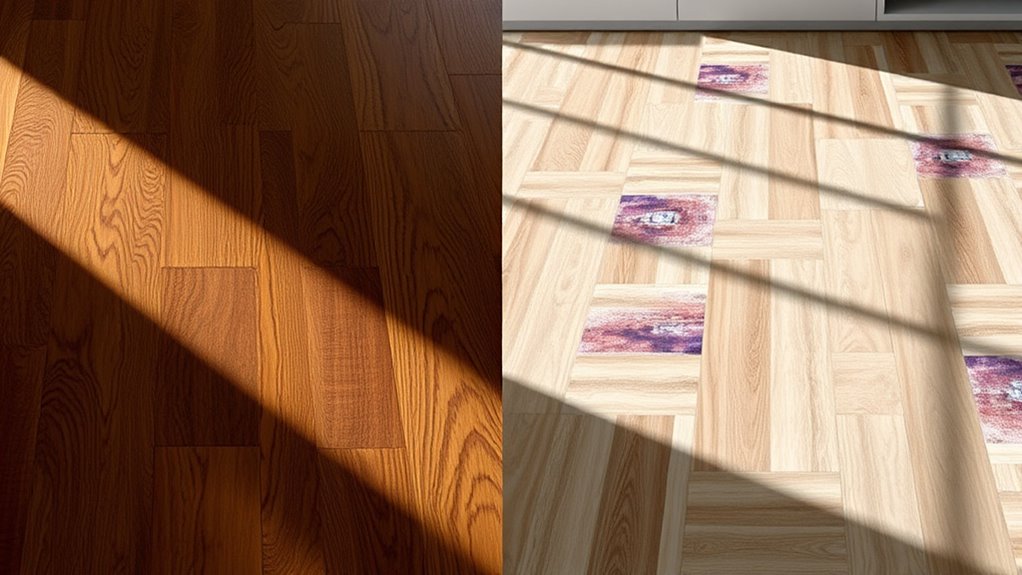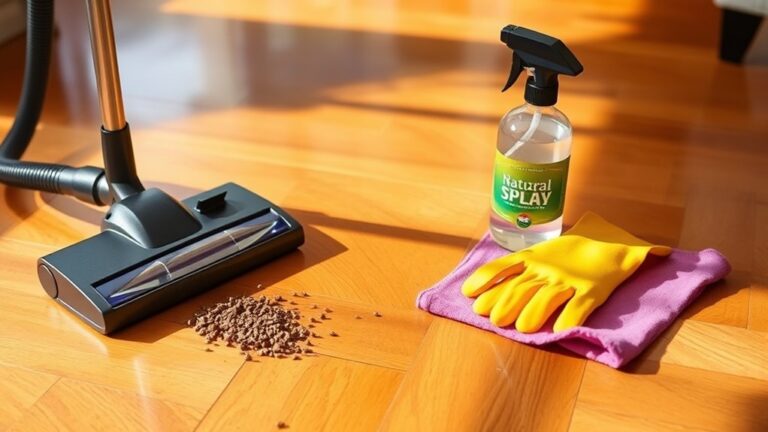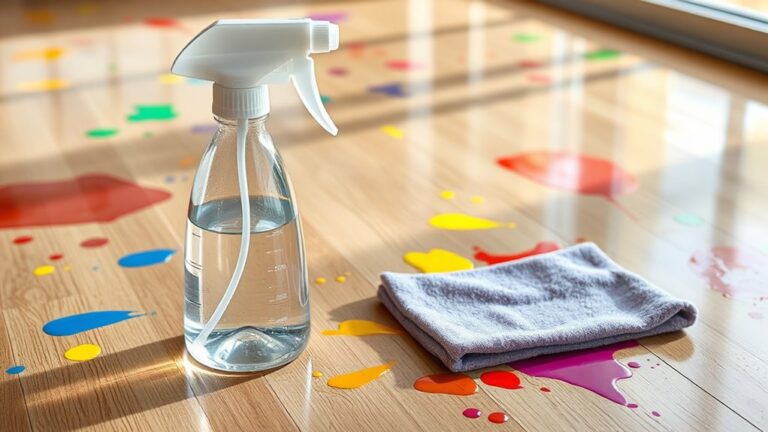You’ll find laminate flooring features a wood-based core with a tough wear layer, giving it strong scratch resistance but less moisture tolerance. Vinyl, made from synthetic PVC, excels in water resistance and flexibility, making it ideal for damp areas. Installation varies, with laminate using click-lock systems and vinyl offering adhesive or locking options. Costs, durability, design variety, and eco-impact differ too. Understanding these basics will help you pick the perfect flooring for your space and lifestyle needs.
Material Composition and Structure
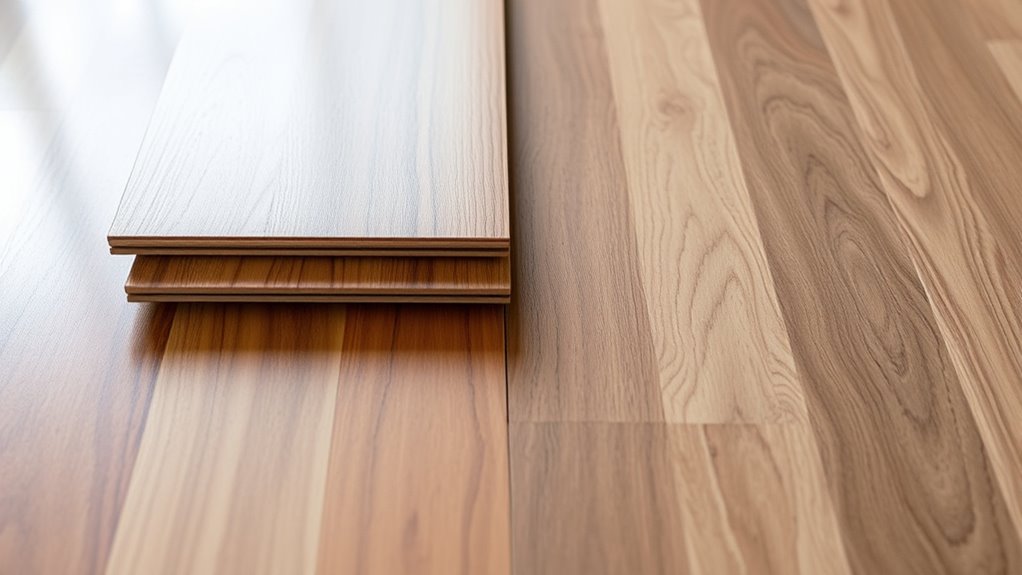
Although both laminate and vinyl flooring aim to mimic the look of natural materials, their composition and structure differ greatly, which affects their performance and suitability for various spaces. Laminate flooring consists of multiple composition layers: a high-density fiberboard core, a photographic applique layer that replicates wood or stone, and a protective wear layer on top. This layered structure offers durability but relies on the core’s stability. Vinyl flooring, on the other hand, is made primarily from synthetic materials like PVC, with composition layers including a backing layer, a printed design layer, and a clear wear layer. These structural differences mean vinyl is generally more flexible and softer underfoot, while laminate feels more rigid and solid. Understanding these composition layers helps you choose flooring that matches your lifestyle and space needs.
Water Resistance and Moisture Tolerance
When choosing between laminate and vinyl flooring, you’ll want to contemplate how each handles water and moisture. Vinyl flooring generally offers higher water resistance, making it a better choice for areas prone to spills or humidity. On the other hand, laminate can be more vulnerable to moisture damage if not properly sealed or maintained.
耐水性レベル
Since moisture can cause significant damage to flooring materials, understanding the water resistance levels of laminate and vinyl flooring is essential for choosing the right option for your space. Vinyl flooring generally offers higher waterproof ratings, making it ideal for areas prone to spills and humidity like kitchens and bathrooms. Many vinyl products come with built-in moisture barriers that prevent water from seeping through, protecting the subfloor beneath. Laminate flooring, on the other hand, has improved moisture tolerance but is not fully waterproof. It often requires additional moisture barriers during installation to reduce water damage risks. If you want freedom from worrying about water exposure, vinyl’s superior water resistance gives you more flexibility in where you install it, while laminate demands more caution and preparation to maintain its durability.
Moisture Damage Risks
Because moisture damage can lead to costly repairs and shorten your 床‘s lifespan, understanding the risks associated with laminate and vinyl flooring is essential. Both materials respond differently to moisture sources, so knowing how to protect your investment is key.
- Laminate flooring is more vulnerable to water damage since its core absorbs moisture, causing swelling and warping. Avoid spills and high humidity to minimize risk.
- Vinyl flooring offers superior moisture tolerance due to its waterproof surface, making it a better choice for areas prone to moisture like kitchens and basements.
- For damage prevention, promptly clean spills, maintain proper ventilation, and use moisture barriers where needed.
Installation Methods and Ease
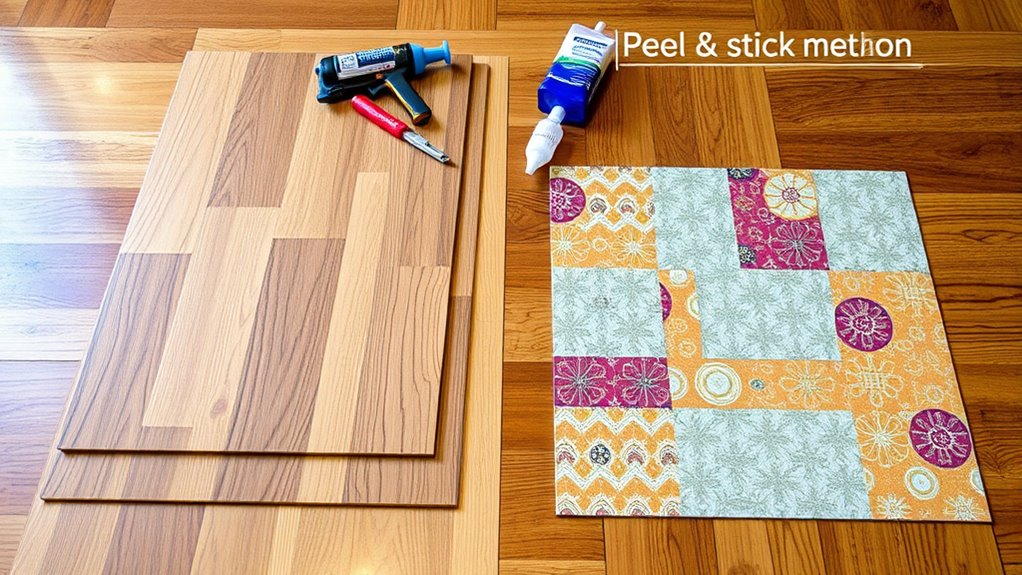
Although both laminate and vinyl flooring are designed for relatively straightforward installation, the methods and tools you’ll need differ quite a bit. Laminate flooring typically uses a click-lock installation technique, where planks snap together without glue or nails. You’ll need basic flooring tools like a saw, tapping block, and spacers. This method is ideal if you want a floating floor that’s easy to replace or upgrade later.
Vinyl flooring installation varies more—sheet vinyl requires adhesive and careful cutting, while vinyl planks often use a locking system similar to laminate. Vinyl is more forgiving on uneven subfloors, so you might spend less time prepping the surface. Vinyl installation tools include a utility knife, roller, and adhesive trowel. Both options offer DIY-friendly techniques, but your choice depends on comfort with tools and how much time you want to invest.
Durability and Scratch Resistance
When choosing between laminate and vinyl flooring, durability and scratch resistance are key factors you’ll want to take into account. Here’s a quick durability comparison to guide your decision:
- Laminate flooring offers strong scratch resistance thanks to a tough wear layer, making it ideal if you have pets or kids.
- Vinyl flooring is highly durable as well, but its softer surface may show scratches more easily, especially in high-traffic areas.
- Both materials resist stains and dents, but laminate generally handles heavy impacts better, while vinyl excels in moisture-prone spaces.
Appearance and Design Variety
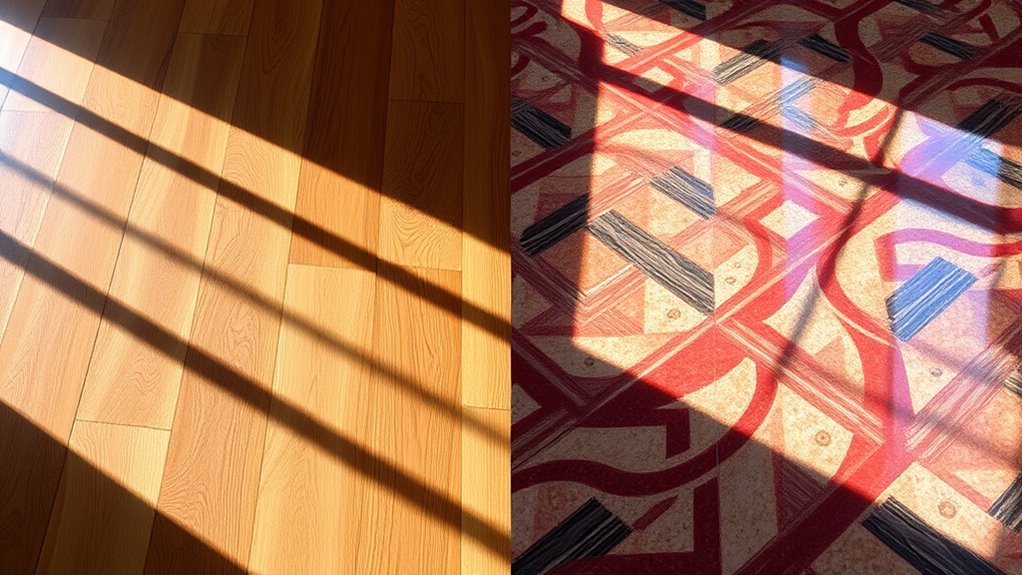
If you want a floor that matches your style perfectly, both laminate and vinyl offer plenty of design options, but they differ in variety and realism. Laminate flooring often excels in mimicking natural wood with detailed grain textures, giving you authentic design patterns and rich color options. It’s ideal if you’re after a classic wood look without the upkeep. Vinyl flooring, on the other hand, provides a wider range of color options and design patterns, including stone, tile, and abstract styles. This makes vinyl great for bold, creative spaces where you want more freedom to express personality. Ultimately, your choice depends on whether you prefer realistic wood-like appearances or diverse, vibrant designs to suit your unique taste.
Comfort and Sound Absorption
Beyond how they look, the feel of your flooring underfoot and how much noise it absorbs can greatly impact your daily comfort. When comparing laminate and vinyl flooring, consider these key points:
- Laminate flooring typically offers better underfoot comfort due to its thicker core and often includes a foam underlayment, enhancing sound insulation and cushioning.
- Vinyl flooring tends to feel softer and warmer than laminate but may require additional padding to improve sound insulation, especially in high-traffic areas.
- Both flooring types can benefit from quality underlays, but laminate’s structure generally provides superior noise reduction, making it ideal if sound insulation is a priority.
Choosing the right flooring means balancing comfort and quietness—both essential for creating a space where you feel truly free and at ease.
Maintenance and Cleaning Requirements
Anyone choosing between laminate and vinyl flooring should consider how much effort each one requires for maintenance and cleaning. Laminate floors need gentle care to prevent scratches and water damage; using a microfiber mop and avoiding excessive water is key. Vinyl flooring is more forgiving—you can use a damp mop and a mild cleaner without worrying about warping. For both, regular sweeping or vacuuming with appropriate cleaning tools helps keep dust and grit from causing wear. Maintenance tips include wiping up spills promptly to avoid stains or damage. Ultimately, vinyl offers more flexibility with cleaning methods, while laminate calls for a bit more caution. Knowing these differences lets you pick the flooring that fits your lifestyle and frees you from complicated upkeep routines.
Cost Comparison and Value
When deciding between laminate and vinyl flooring, understanding the cost difference and overall value is just as important as knowing how to care for them. Here’s what you should consider:
- Upfront cost: Laminate flooring often comes with a lower initial price, making it appealing if you’re watching your budget considerations closely.
- Installation expenses: Vinyl usually offers easier, sometimes DIY-friendly installation, potentially saving you money on labor.
- Long term investment: Vinyl tends to be more durable and water-resistant, which can mean fewer repairs or replacements down the line, adding value over time.
Environmental Impact and Sustainability
When choosing between laminate and vinyl flooring, it’s important to evaluate how their materials affect the environment. You’ll want to think about recyclability and how each type is disposed of at the end of its life. Understanding these factors can help you make a more sustainable flooring choice.
Material Composition Effects
Understanding the material composition of both laminate and vinyl flooring is essential if you care about environmental impact and sustainability. The way these materials are made affects their durability, texture differences, and ultimately their footprint.
- Laminate flooring combines wood fibers with resin, offering high material durability but relying on natural resources.
- Vinyl flooring is primarily made from PVC, a synthetic material that provides moisture resistance and diverse texture options but involves petrochemicals.
- The manufacturing processes differ: laminate often uses less energy, while vinyl production can emit more pollutants.
Recyclability and Disposal
Since disposal methods greatly impact the environment, you should consider how recyclable laminate and vinyl flooring are before making your choice. Laminate flooring is primarily wood-based, making it easier to recycle through standard wood recycling options. However, its composite layers can complicate disposal if recycling facilities don’t accept mixed materials. Vinyl flooring, made from PVC, poses more challenges; it’s less biodegradable and requires specialized recycling programs that aren’t widely available. When discarding vinyl, disposal methods often involve landfill or incineration, which can harm the environment. To maintain your freedom in flooring choice and sustainability, check local recycling options and disposal methods before purchase. Knowing these factors helps you pick flooring that aligns with your environmental values and long-term responsibility.
Suitable Applications and Room Compatibility
Choosing the right flooring depends largely on the specific needs of each room in your home. When considering room suitability and application preferences, both laminate and vinyl offer distinct advantages.
- High-moisture areas: Vinyl shines in bathrooms and kitchens because it resists water and humidity better than laminate.
- Living spaces: Laminate is ideal for bedrooms and living rooms, offering a sturdy surface with a hardwood look at a lower cost.
- Basements and laundry rooms: Vinyl’s waterproof nature makes it preferable where moisture is a concern.
Understanding these differences helps you pick flooring that fits each room’s demands, giving you the freedom to create comfortable, functional spaces without compromise.

